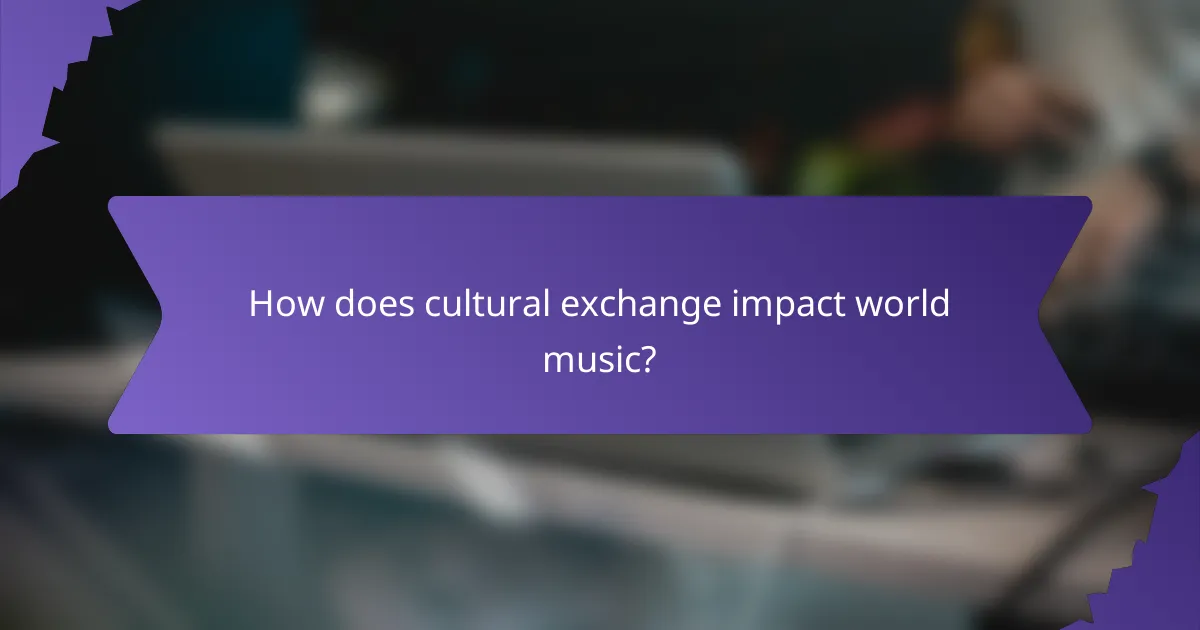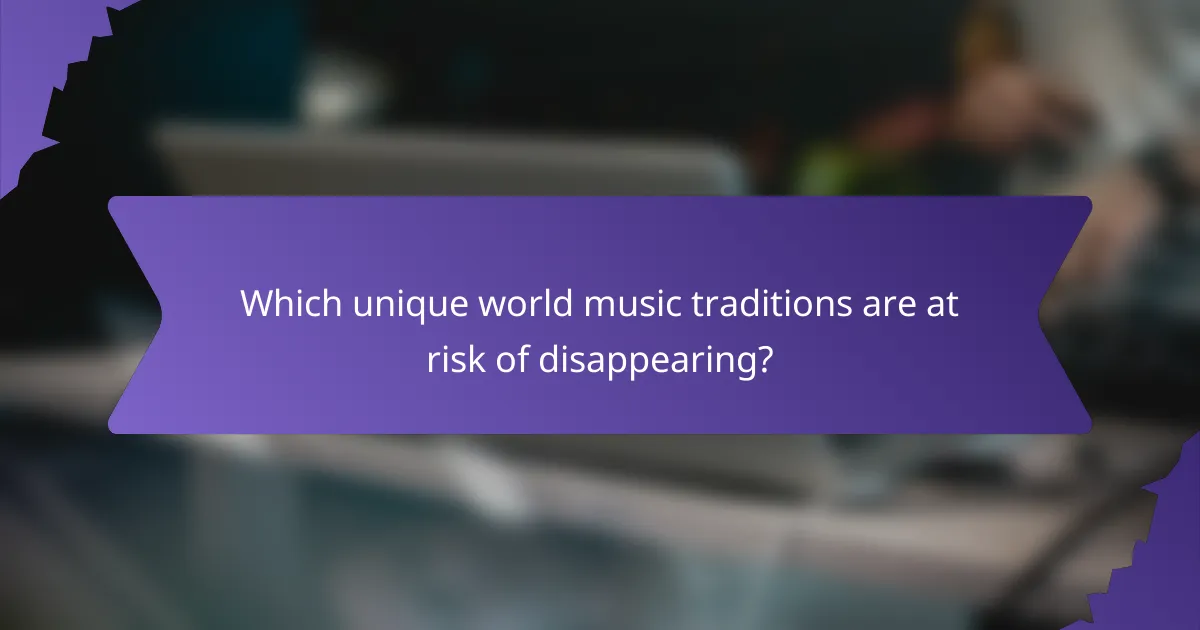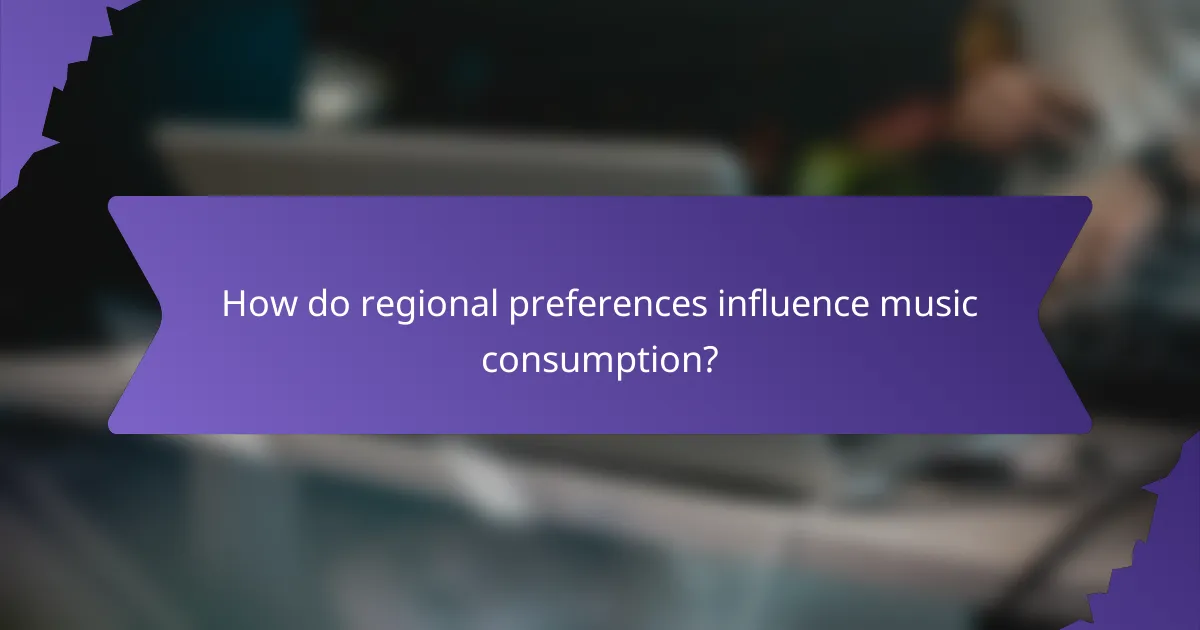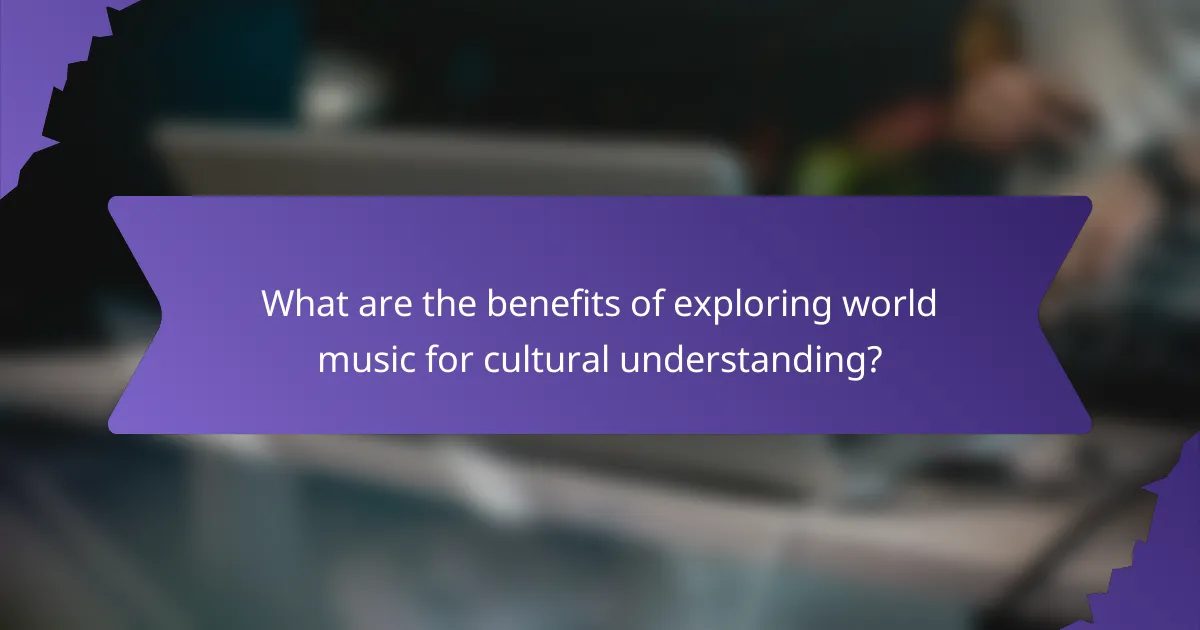World music offers a unique lens into cultural diversity and fusion genres. It highlights the blending of traditional and contemporary sounds, showcasing collaboration among artists. Cultural exchange enriches these musical forms, promoting innovation and creativity. Additionally, understanding regional preferences shapes music consumption and influences global trends.

What defines the essence of world music?
World music embodies a rich tapestry of cultural diversity, fusion genres, and exchange. It reflects the blending of traditional and contemporary sounds from various cultures, creating unique musical expressions. This genre emphasizes collaboration among artists from different backgrounds, fostering global connections. For instance, the incorporation of African rhythms in Western pop music demonstrates this cultural synergy. The essence of world music lies in its ability to transcend borders, celebrating the shared human experience through varied musical forms.
How do cultural influences shape musical styles?
Cultural influences shape musical styles by blending traditions, instruments, and rhythms from diverse backgrounds. This fusion creates unique genres that reflect the histories and experiences of different communities. For example, reggae emerged from Jamaican culture, incorporating African rhythms and American jazz influences. As a result, cultural exchange fosters innovation and diversity in world music, allowing artists to express their identities through new sounds. Collaboration across cultures often leads to the creation of hybrid genres, showcasing the power of music as a universal language.
Which instruments are commonly used across different cultures?
Various instruments are used globally, reflecting cultural diversity. Common instruments include the guitar, violin, drums, flute, and piano. Each instrument carries unique cultural significance, such as the djembe in West African music and the sitar in Indian classical music. These instruments often fuse across genres, creating rich musical landscapes.

What are the key characteristics of fusion genres?
Fusion genres blend diverse musical styles, creating unique sounds that reflect cultural exchange. Key characteristics include the incorporation of traditional instruments, cross-genre collaborations, and the blending of distinct rhythms and melodies. These genres often emphasize improvisation and innovation, allowing artists to express their cultural identities while reaching broader audiences. The result is a rich tapestry of music that fosters appreciation for global diversity.
How do traditional elements blend with modern sounds?
Traditional elements blend with modern sounds through cultural exchange and fusion genres. This interaction creates innovative music that reflects diverse influences. Traditional instruments often merge with contemporary production techniques, enhancing global appeal. For example, the incorporation of African rhythms in pop music showcases this synthesis. Additionally, collaborations between artists from different backgrounds promote cross-cultural dialogue. This blending enriches the music landscape, fostering creativity and new genres.
Which fusion genres are gaining popularity in 2025?
Fusion genres such as Afrobeat, Reggaeton, and K-Pop are gaining significant popularity in 2025. These genres blend traditional elements with modern influences, fostering cultural exchange. Afrobeat combines African rhythms with jazz and funk, while Reggaeton merges Latin sounds with hip-hop. K-Pop continues to innovate by incorporating diverse musical styles, appealing to a global audience. The rise of digital platforms amplifies these genres, making them accessible worldwide.

How does cultural exchange impact world music?
Cultural exchange significantly enriches world music by fostering diversity and creating fusion genres. It allows different musical traditions to blend, resulting in innovative sounds and styles. This interaction promotes collaboration among artists from various backgrounds, enhancing creativity and broadening audiences. As a result, cultural exchange leads to the emergence of unique music forms that reflect global influences.
What role do festivals play in promoting cultural diversity?
Festivals play a crucial role in promoting cultural diversity by celebrating various musical traditions. They serve as platforms for cultural exchange, allowing artists from different backgrounds to collaborate and create fusion genres. This interaction enhances mutual understanding and appreciation among diverse communities. Festivals often feature a mix of performances, workshops, and activities that highlight unique cultural attributes, fostering inclusivity. As a result, they contribute to the preservation and evolution of world music, ensuring that diverse cultural expressions thrive.
How do collaborations between artists from different backgrounds enhance creativity?
Collaborations between artists from different backgrounds significantly enhance creativity by blending diverse musical styles and cultural influences. This fusion leads to innovative sounds and fresh perspectives, enriching the artistic landscape. Cultural exchange fosters understanding and appreciation, allowing artists to experiment beyond their traditional confines. For example, the emergence of genres like Afrobeat combines African rhythms with jazz and funk, showcasing the power of collaboration. Such interactions not only create unique music but also promote social cohesion and dialogue among different communities.

Which unique world music traditions are at risk of disappearing?
Several unique world music traditions are at risk of disappearing due to globalization and cultural homogenization. Indigenous music forms, such as the Inuit throat singing and the Tuvan throat singing, face declining participation. Traditional instruments like the Australian didgeridoo and the Indian sitar are also at risk as younger generations gravitate toward modern music styles. Additionally, regional folk traditions, such as the Irish sean-nós singing and the Spanish flamenco, struggle to maintain their authenticity amid commercial influences. Preservation efforts are crucial to sustain these unique musical heritages.
What efforts are being made to preserve endangered musical forms?
Efforts to preserve endangered musical forms include documentation, education, and community engagement. Organizations are recording traditional music and conducting workshops to teach these art forms. For example, the Smithsonian Folkways Recordings archives diverse global music, ensuring cultural heritage is maintained. Additionally, initiatives promote cultural exchange, allowing fusion genres to emerge while respecting original traditions. These collaborative efforts help sustain the diversity of world music, fostering appreciation and understanding.

How do regional preferences influence music consumption?
Regional preferences significantly shape music consumption by influencing genre popularity and artist recognition. Cultural backgrounds, local traditions, and social contexts dictate which styles resonate with audiences. For instance, Latin music thrives in regions with strong Hispanic communities, while K-pop’s rise reflects Asian cultural influence.
Moreover, globalization fosters fusion genres that blend regional sounds, appealing to diverse listeners. This cultural exchange enriches music landscapes, encouraging artists to experiment beyond their roots. Unique attributes, like regional instrumentation, further enhance the authenticity of music, making it more relatable to local audiences.
As a result, music consumption becomes a reflection of both global trends and local tastes, creating a dynamic interplay that continuously evolves. Understanding these influences helps artists and producers tailor their work to meet audience expectations effectively.
What platforms are most popular for discovering world music in different regions?
Streaming services, social media, and dedicated music platforms are popular for discovering world music across regions. Platforms like Spotify and Apple Music offer curated playlists highlighting diverse genres. YouTube serves as a significant resource for exploring global music videos and live performances. Local platforms, such as Anghami in the Middle East and JioSaavn in India, cater to regional tastes and promote cultural exchange. Additionally, SoundCloud allows independent artists to share their music, fostering fusion genres and collaboration.
How do local audiences engage with global music trends?
Local audiences engage with global music trends through cultural adaptation and personal expression. They incorporate diverse genres into their own musical landscapes, creating unique fusions. For instance, hip-hop influences have led to local variations in countries like Brazil and Nigeria. This cultural exchange fosters a sense of community and identity among listeners. Additionally, social media platforms amplify these interactions, allowing audiences to discover and share global music trends instantly.

What are the benefits of exploring world music for cultural understanding?
Exploring world music enhances cultural understanding by fostering empathy, appreciation, and connection among diverse communities. Exposure to various musical traditions helps individuals recognize the uniqueness of different cultures while identifying shared human experiences.
World music promotes cultural exchange, allowing for fusion genres that blend elements from multiple traditions. This fusion creates new artistic expressions, enriching cultural landscapes and encouraging dialogue among communities.
Additionally, engaging with world music can lead to increased cultural awareness and sensitivity. By understanding the stories and histories behind different musical styles, listeners can develop a deeper respect for the cultural contexts from which they originate.
Overall, world music serves as a powerful tool for building bridges between cultures, promoting inclusivity, and celebrating diversity.
How can world music education foster appreciation for diversity?
World music education fosters appreciation for diversity by exposing students to various cultural perspectives through music. This exposure promotes understanding and respect for different traditions and practices.
Engaging with diverse musical genres encourages students to explore fusion genres, which often blend elements from multiple cultures. As a result, learners develop an appreciation for the interconnectedness of global music.
Participating in world music education can enhance cultural exchange, allowing students to collaborate with peers from different backgrounds. This collaboration builds empathy and broadens their worldview.
Furthermore, world music programs often include unique instruments and styles, which highlight the rich tapestry of human expression. Such experiences can lead to a lifelong appreciation for cultural diversity.
What are the common misconceptions about world music?
Common misconceptions about world music include the belief that it is a single genre or that it lacks authenticity. World music encompasses diverse styles and cultural influences, making it a rich tapestry of sounds. Many people mistakenly think that fusion genres dilute cultural heritage, but they often enhance cultural exchange and innovation. Another misconception is that world music is only traditional or folk-based, while contemporary artists are redefining the genre with modern influences.
What practical strategies can enhance your world music experience?
To enhance your world music experience, immerse yourself in diverse genres and cultural contexts. Explore local music scenes and attend live performances to connect with artists and communities. Utilize streaming platforms to discover fusion genres that blend various musical traditions. Engage in workshops or classes to learn instruments or dance styles, deepening your appreciation. Collaborate with others to create music that reflects cultural exchanges, enriching your understanding of global sounds.